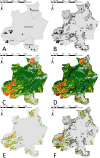Geographic distribution of isolated indigenous societies in Amazonia and the efficacy of indigenous territories
- PMID: 25970612
- PMCID: PMC4430527
- DOI: 10.1371/journal.pone.0125113
Geographic distribution of isolated indigenous societies in Amazonia and the efficacy of indigenous territories
Abstract
The headwaters of the Amazon Basin harbor most of the world's last indigenous peoples who have limited contact with encroaching colonists. Knowledge of the geographic distribution of these isolated groups is essential to assist with the development of immediate protections for vulnerable indigenous settlements. We used remote sensing to document the locations of 28 isolated villages within the four Brazilian states of Acre, Amazonas, Roraima, and Rondônia. The sites were confirmed during previous over-flights and by image evidence of thatched-roof houses; they are estimated to host over 1,700 individuals. Locational data were used to train maximum entropy models that identified landscape and anthropogenic features associated with the occurrence of isolated indigenous villages, including elevation, proximity to streams of five different orders, proximity to roads and settlements, proximity to recent deforestation, and vegetation cover type. Isolated villages were identified at mid elevations, within 20 km of the tops of watersheds and at greater distances from existing roads and trails. We further used model results, combined with boundaries of the existing indigenous territory system that is designed to protect indigenous lands, to assess the efficacy of the existing protected area network for isolated peoples. Results indicate that existing indigenous territories encompass all of the villages we identified, and 50% of the areas with high predicted probabilities of isolated village occurrence. Our results are intended to help inform policies that can mitigate against future external threats to isolated peoples.
Conflict of interest statement
Figures



References
-
- Vaz A (2011) Isolados no Brasil Política de estado: da tutela para a política de direitos—uma questão resolvida? Brasília, Brazil: Estação Gráfica.
-
- Hemming J (1978) Red gold: the conquest of the Brazilian Indians 1500–1760 New York, NY: Dutton.
-
- Hurtado M, Hill K, Kaplan H, Lancaster J (2001) The epidemiology of infectious diseases among South American Indians: A call for guidelines for ethical research. Curr Anth 42: 425–432. - PubMed
Publication types
MeSH terms
LinkOut - more resources
Full Text Sources
Other Literature Sources

